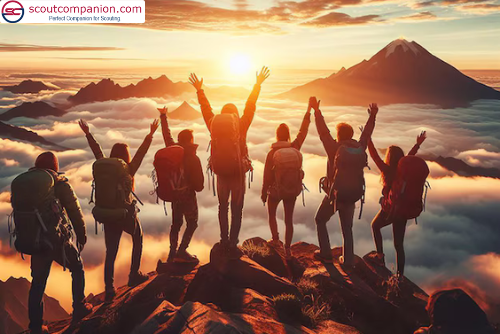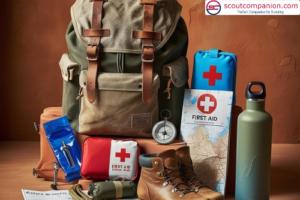High-adventure scouting trips are a fun way to explore nature, try new challenges, make great memories and learn more about nature and yourself. These trips are more than just regular scouting camp trips. You will climb mountains, paddle rivers, or explore wild places. They help you grow stronger both physically, mentally and personally. To enjoy these trips, you need to get ready. Getting ready means staying active, learning scouting skills like reading maps, emergency rescues, and packing the right gear for the right activities. This guide will help you know what to expect, how to prepare, and how to have the best adventure. To learn more about high-adventure trips, you can visit Boy Scouts of America Official Site.
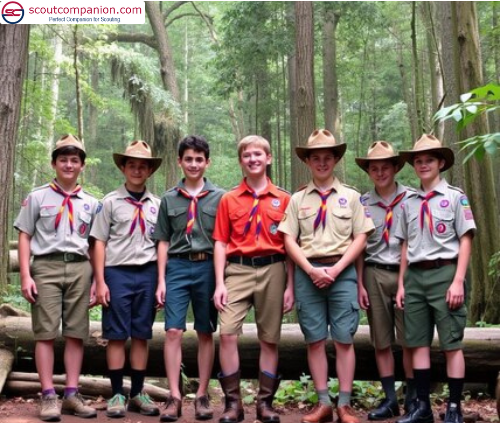
Table of Contents
Introduction
As high-adventure scouting trips pave a great way to experience nature in a deeper way they also have tough challenges to face with at the time of trips. These trips take you to interesting places far from the usual scouting spots, where you can enjoy nature without the distractions of technology. Activities like spending days in the wild or facing tough trails and terrains will make the entire trip worthy. The main thing about this high-adventure trip is not just about reaching the end, but to enjoy every moment of the trip. At the end of the day this trip is all about learning new skills and finding the real you apart from having fun.
What is the Need for High-Adventure Trips in Scouting?
Scouts include high-adventure trips in their training because they provide more than just the basic outdoor skills learned on regular trips. These trips give scouts an opportunity to face bigger challenges and push themselves both physically and mentally. Here are some of the points that justify the importance of including high-adventure trips in scouting.
- Physical and Mental Growth : High-adventure trips activities include hiking and climbing which helps the scouts to build strength, endurance and fitness. And mentally they teach problem solving, staying calm under pressure and so on.
- Learning New Skills : On high-adventure trips scouts learn advanced outdoor skills like using map and compass for navigation, handling emergencies, and surviving in the wild.
- Building Confidence: High-adventure trips help scouts grow in confidence when they get the chance to lead scout teams as leaders.
- Personal Growth: These trips are not just about physical activities. They also help scouts grow personally as scouts learn leadership, teamwork, and decision-making skills which last their lifetime.
- Connecting with Nature: High-adventure trips often take scouts into remote places where they disconnect from technology and truly connect and experience nature.
Essential Preparations for High-Adventure Scouting Trips
Preparing for high-adventure scouting trips is important because it ensures you are physically, mentally and logistically ready for the challenges you will be facing at the scouting spot. Lack of preparedness will result in struggles while facing challenges like unexpected weather changes, tough terrain, crossing natural blockages like rivers, mountains in the route and so on. But preparations will help you to reduce risks, such as injury and getting lost. Preparation also includes making sure that you have the right gear for the activities you will be having in the trip, food and water, and appropriate clothes as per the weather condition in the tripping location. Now let’s look at some of the essential preparations needed for high-adventure trips.
- Physical Preparation
- Mental Readiness
- Packing Essential Gear
- Pre-trip Planning and Training
- Checkups during the trip
- Post-trip Reflection
1. Physical Preparation
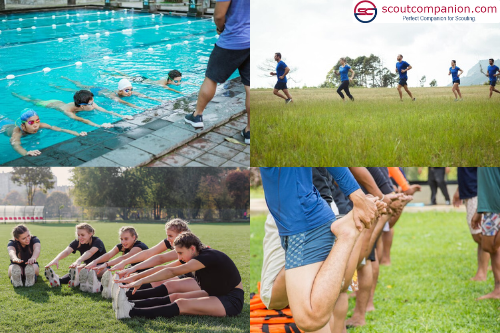
Physical preparation is important for high-adventure trips because they make the scouts ready for tough activities like hiking, paddling, and climbing in difficult environments as these activities will be included in the high-adventure trips. These trips often last for days and take place in places like mountains, forests, or along rivers.
To get ready for this trip, scouts should focus on building endurance through physical activities like running, swimming and strength training exercises for muscles in the legs, core, and shoulders. Flexibility and balance exercises help prevent injuries and make it easier to navigate through rough terrain. Good physical training ensures scouts can enjoy the trip and stay safe throughout the adventure.
Scouts should try hiking while carrying a loaded backpack to get their shoulders and back used to the weight. It’s also important to wear the same hiking boots during practice to break them in and avoid getting blisters later. Staying hydrated and eating well during training helps the body stay strong and ready for the challenges of the trip, keeping scouts energized and prepared for the adventure ahead.
Building Endurance and Strength
- Cardiovascular Training
- Activities such as hiking, running, swimming, or cycling build cardiovascular endurance, which is important for long hikes or paddling sessions.
- Start training at least 2–3 months before the trip.
- Gradually increase the intensity and duration of your workouts.
- Strength Training
- Building muscle strength is vital for carrying heavy backpacks, paddling, or climbing.
- Focus on exercises for core strength, legs, and shoulders, like squats, lunges, and planks.
- Incorporate resistance training with weights or resistance bands.
- Flexibility and Balance
- Stretching and yoga can improve flexibility and reduce the risk of injury.
- Balance exercises help when navigating uneven terrain or performing activities like canoeing.
Practice Outdoor Activities
- Hiking: Take practice hikes with a loaded backpack to simulate real conditions.
- Paddling: If the trip involves canoeing or kayaking, practice paddling on local lakes or rivers.
- Climbing: Attend climbing gyms or outdoor rock-climbing sessions to gain confidence and skills.
Health Considerations
- Medical Checkup: Ensure you’re fit for the planned activities. Discuss any existing medical conditions with your doctor.
- Injury Prevention: Learn about common injuries, like blisters or sprains, and how to prevent them.
- Hydration and Nutrition: Develop a habit of drinking plenty of water and eating nutritious meals to fuel your body during training.
2. Mental Readiness

Mental readiness is just as important as physical preparation for high-adventure trips. These trips can be tough, with unexpected challenges like bad weather, difficult terrain, or group issues like misunderstanding and lack of cooperation among scout members. Being mentally strong helps scouts stay calm, positive, and focused when things don’t go as planned.
A good attitude makes it easier to push through tough moments and solve problems on the scouting spot. Practicing mental skills like staying flexible, visualizing success, and managing stress can help scouts stay confident and keep going. Mental readiness helps scouts handle challenges and enjoy the adventure, even when things get difficult.
Building mental readiness also involves teamwork and communication. Scouts should practice working together, listening to each other, and resolving conflicts calmly before the trip. When everyone works as a team, challenges feel smaller, and the adventure becomes a shared, rewarding experience.
Developing a Positive Mindset
- Embrace Challenges
- High-adventure trips often test your limits.
- Cultivating a positive attitude and viewing obstacles as opportunities for growth can enhance your experience.
- Stay Adaptable
- Weather changes, unexpected delays, or equipment failures can occur.
- Practice remaining calm and flexible when plans change.
- Teamwork and Leadership
- Foster good communication and collaboration with your team.
- Practice leadership skills, such as decision-making and conflict resolution, during pre-trip activities.
Mental Preparation Techniques
- Visualization: Imagine yourself succeeding in various scenarios, such as climbing a steep trail or navigating a river.
- Mindfulness: Practice mindfulness or meditation to stay present and manage stress.
- Problem-Solving Skills: Learn to assess situations logically and make sound decisions under pressure.
Learn Outdoor Skills
- Navigation: Master the use of maps, compasses, and GPS devices.
- First Aid: Take a wilderness first aid course to prepare for medical emergencies.
- Survival Skills: Learn basics like fire-starting, shelter building, and finding clean water sources.
3. Packing Essential Gear
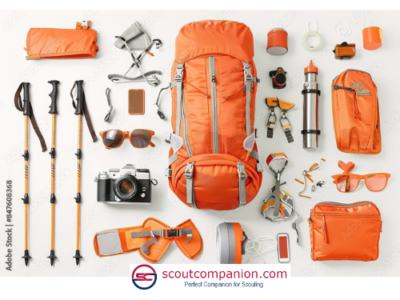
Packing the right gear is crucial for a successful high-adventure trip. The gear you choose should be functional, lightweight, and appropriate for the activities and environment you’ll face. Having the right equipment can make the difference between a great experience and a miserable one.
For example, a well-fitting backpack can help distribute weight evenly and reduce strain on your body. Clothing made from moisture-wicking materials will keep you comfortable in changing weather, while a lightweight, compact sleeping bag ensures a good night’s rest. Each item should serve a specific purpose, and being prepared with the right tools makes the journey safer and more enjoyable.
It’s also important to pack essential safety items like a first aid kit, a multi-tool, a map, and a compass can be lifesavers in unexpected situations. Don’t forget a reliable source of light, like a headlamp, and extra batteries. Packing smart ensures you’re ready for any challenges along the way.
Backpack and Packing
- Choosing a Backpack
- Select a backpack with the appropriate capacity (40–70 liters for most trips).
- Ensure it fits comfortably, with adjustable straps and a padded hip belt.
- Packing Essentials
- Clothing: Go for moisture-wicking, quick-drying, and layered clothing to adapt to weather changes. Include a waterproof jacket and extra socks.
- Sleeping Gear: A lightweight sleeping bag suitable for the expected temperatures, along with a compact sleeping pad, is essential.
- Food and Cooking: Pack lightweight, high-energy meals, and snacks. Bring a portable stove, utensils, and fuel.
Navigation and Communication
- Maps and Compass: Always carry a detailed map and a compass as primary navigation tools.
- GPS Device: A handheld GPS or smartphone app can be a useful backup.
- Emergency Communication: Bring a whistle, signal mirror, or satellite phone for emergencies.
Safety and First Aid
- A well-stocked first aid kit tailored to the activities and group size.
- Multi-tool or knife for various tasks.
- Emergency shelter, like a space blanket or bivy sack.
Hydration and Filtration
- Carry enough water for daily needs (at least 2–3 liters per person).
- A portable water filter or purification tablets for refilling from natural sources.
Personal Items
- Sunscreen and sunglasses to protect against UV rays.
- Insect repellent, especially in areas with mosquitoes or ticks.
- Personal hygiene items like biodegradable soap, toothbrush, and a trowel for digging catholes.
4. Pre-Trip Planning and Training

Pre-trip planning and training are essential to make sure everything goes well on a high-adventure trip. Pre-trip planning should start from researching the high-adventure destination to knowing the terrain, weather, and any rules or permits you may need. Practice with shorter trips to test out your gear, skills, and physical fitness so you’re prepared for longer and more challenging days. As a team, assign specific roles like navigator, cook, or medic, and plan for emergencies in case something goes wrong.
It’s also important to learn and follow Leave No Trace (LNT) principles to protect the environment which means things like packing out all trash, staying on trails, and respecting wildlife so that the beautiful places you visit stay healthy and untouched for future adventures. The more you prepare, the more confident and safe you’ll feel during the high-adventure trip.
Research the Destination
- Understand the terrain, climate, and wildlife of the area.
- Familiarize yourself with local regulations, such as permits or restricted areas.
Practice Runs
- Organize shorter trips to test your gear, skills, and physical fitness.
- Conduct mock scenarios, such as setting up a tent in the rain or navigating using a map.
Team Preparation
- Assign roles, such as navigator, cook, or medic, to each team member.
- Discuss contingency plans for emergencies, such as injuries or getting lost.
Leave No Trace Principles
- Educate yourself on minimizing environmental impact by following Leave No Trace principles:
- Plan ahead and prepare.
- Travel and camp on durable surfaces.
- Dispose of waste properly.
- Leave what you find.
- Minimize campfire impact.
- Respect wildlife.
- Be considerate of other visitors.
5. Checkups during the trip
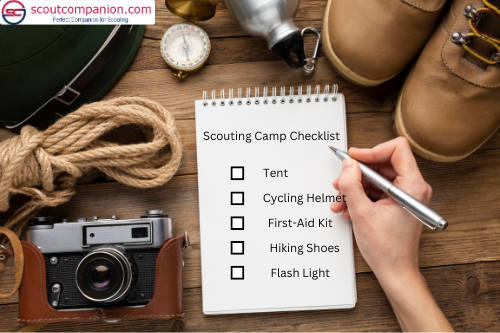
During the trip, regular checkups are very important to keep everyone safe and healthy. Make sure to drink plenty of water to stay hydrated and eat enough food to keep your energy up. Check your feet often for blisters or soreness and fix any problems right away. Take breaks when you’re tired so you don’t overwork yourself. Talk to your group about how everyone is feeling. If someone seems too tired, sick, or dehydrated, take steps to help them. Watch the weather carefully if any changes are spotted you need to adjust your plans.
Also, check your gear every day. Make sure backpacks are packed properly, shoes are in good shape, and water bottles are clean and full. Also look over important items like first aid kits, maps, and emergency tools to make sure they’re ready to use. These small checkups help avoid bigger problems.
Regular checkups should also include monitoring everyone’s skin for sunburn or insect bites, especially during long days outdoors. Also check your clothing for signs of wear, like tears or wetness to stay dry and comfortable. Pay attention to how everyone is coping mentally by having open communications and addressing any concerns like stress or frustration early. These regular checkups keep the group safe, comfortable, and ready to handle the adventure ahead.
Stay Safe
- Regularly check weather conditions and adjust plans accordingly.
- Stick to established trails and campsites whenever possible.
- Communicate openly with your group about your physical and mental condition.
Monitor Your Health
- Stay hydrated and eat regularly to maintain energy.
- Address minor issues, such as blisters or dehydration, before they escalate.
- Take breaks as needed to prevent fatigue.
Capture the Experience
- Keep a journal to document your adventure.
- Take photos to share memories with family and friends.
6. Post-Trip Reflection

Post-trip reflection is an important step after any high-adventure trip. It’s your chance to look back on the journey and understand what worked, what didn’t, and what you can improve next time. Start by thinking about your favorite moments and what made them special? Then, reflect on the challenges you faced. Was it the terrain, the weather, or perhaps teamwork? Consider what you learned from those moments and how you overcame them.
Have a group discussion to share experiences, give feedback, and learn from each other. Celebrate what went well, whether it was successfully navigating tough terrain, working together as a team, or simply making it through a difficult day. At the same time, talk about areas for improvement, like better packing, planning, or communication.
Don’t forget to take care of your gear. Clean, repair, and store it properly so it lasts for future trips. Reflect on the personal growth you experienced. Did the trip help you build confidence, learn new skills, or grow closer to your team? Post-trip reflection isn’t just about the adventure itself. It’s about turning the experience into lasting memories, life lessons, and better preparation for your next adventure.
Conclusion
High-adventure scouting trips are incredible experiences that challenge you physically, mentally, and emotionally while immersing you in the beauty of nature. These trips are not just about reaching a destination but also about the journey, personal growth, and building life skills. Preparing properly is essential to stay safe and make the most of the adventure. Regular checkups during the trip are crucial to navigating challenges like tough terrain, changing weather, or group dynamics. After the trip, reflecting on what you learned helps turn those challenges and successes into lifelong lessons. These adventures teach you resilience, teamwork, problem-solving, and the importance of preparation along with unforgettable memories.
